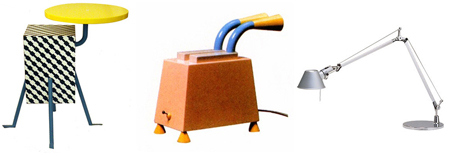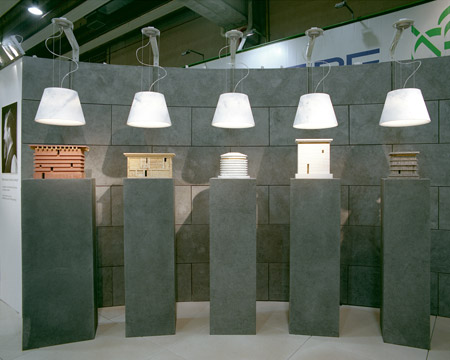29 Settembre 2008
English
Michele De Lucchi, an architect devoted to industry
[videointervista]10_micheledelucchi.swf[/videointervista]
“Although being involved in different disciplines, I actually do just one job, that is to say interfacing industry in all its problems linked to communication, but above all to its identity and its nature. In all these years I’ve learned to understand industry managing to properly match its functions in various aspects, giving character and personality to the different manifestations which the company express itself through.”1
Michele de Lucchi, an architect who dedicated most of his professional career to industry, presents with these words the role he undertook in these years in the companies he collaborated to. A role that identifies the industrial designer as a trait d’union among industry, consumers, culture and research, as the creator of a surplus value for the company, now indispensable in the evolutionary path of contemporary productive scene.
In this viewpoint, Michele De Lucchi is now collaborating with Pibamarmi, that in the occasion of the 42nd Marmomacc exhibition, participated in the “Marmomacc meets Design” initiative. This event gave the opportunity to stone-specialized companies to relate with worldwide renowned design artists in a common path of research and experimentation concentrated on stone industry products.
Pibamarmi chose to collaborate with De Lucchi for his important and innovative professional career. This new experience showed to be able to answer the company’s exigencies, bringing to its productivity creative stimulations very rich in future perspectives.
Author Profile
The principal moments in Michele De Lucchi’s career developed above all through experiences that could apparently seem non homogenic, characterized by changeable formal approaches. But a more careful analysis reveals a path signed by a continuous fil rouge that lets us discover the work of this great contemporary designer and helps us understand his new project begun with Pibamarmi.
Born in Ferrara in 1951, De Lucchi graduated in architecture at Florence University, two years after the founding, in 1975, of the experimental group Cavart (art of caves), that is formed in Padua as a promoter of debates, workshops and performances.
Together with Cavart, De Lucchi organizes seminaries and participates in competitions as “Progettarsi addosso”, “Culturally Impossible Architectures” and “Homo Trahens”, based on experimentation and contestation, seeing apparently recreational activities linked to the habitation world becoming protest actions aimed to create a common critic voice against consumerist society.
De Lucchi’s first professional experiences can be inserted in an interesting atmosphere of renovation of the radical architecture, which characterizes most part of the architectural Italian panorama in the ’70s. His career begins with the contestation of a certain “manner” of doing architectures and design, yet obsolete and far from real contemporary human needs, in the domain of conceptual art that just wants to “communicate messages”. The scene in which De Lucchi operates in his beginnings is the theory of communication, how it can be testified by his 1973 performance at Milan XV Triennale: wearing a Napoleonic military suit, he claims himself as a “Generic Designer” and underlines the ethical responsibility of the designer, creator of objects that influence users’ behaviour.
Since 1977, De Lucchi joined new groups, project studios and revues operating in Milan, from Alchymia to Centrokappa to Modo magazine, and thanks to them his first utopic projects are brought to life into tangible and functional manufuctures.
Passage from theory to practice happens slowly, through the design of a series of objects, called “kind objects”, that De Lucchi projects in the Alchymia context. With sinuous and light colours and shapes, these every-day objects – essentially “Sinerpica” and “Sinvola” lamps, designed in 1978 and 1979 respectively – get in touch with the domestic space as little recreational stories that contrast the aggressiveness of technological supplies in contemporary houses.
Between 1979 and 1981, De Lucchi collaborates with Girmi in creating new home appliances as vacuum cleaners, kettles, toasters, irons, conceived in form of animated characters composed of pure and pastel-coloured geometrical volumes.
At the same time, within Alchymia, De Lucchi meets Alessandro mendini, Andrea Branzi and Ettore Sottsass; with Sottsass, in 1980 he decided to split up with the group and found Memphis the following year2.

Design ojects created by Michele De Lucchi. “Kristall” plastic laminate table, wood and metal, Memphis, 1981; toaster, Girmi, 1979, exhibited in “La casa decorata (Decorated house)” at Milan XVI Triennale, 1980; “Tolomeo” lamp, Artemide, 1986
Memphis opens new ways in designing
Central experience of the Italian avanguardia in the ’80s, Memphis is the nickname of a group of architects and designers coming from all over the world, who, throughout seven years of collaboration, concentrated on the “object” as the central topic of their intellectual research. Their projects developed stressing the attention on colours, decorations, flexibility and formal experimentation; they created emotional and artistical objects that were more than mere tradable functional goods. These objects presented by Memphis mostly were changeable and all-purpose and their colours, shapes and decorations became the instruments for a research on the nature of materials and surfaces, characteristic that would influence De Lucchi’s whole career.
Through Memphis, probably the most enduring and fundamental experience in his career, De Lucchi developed his own research toward a unconventional design aimed to represent human feelings.
In 1979, contacted by Ettore Sottsass, then responsible for Olivetti’s product design and office furniture, De Lucchi stars his collaboration with that company3. Initially he managed the development of Olivetti products as the ones in Icarus and Delphos lines, designed with Sottsass, and of technological appliances as personal computers, phones, copiers and printers.
Even if apparently different from the first objects designed by him, Olivetti products, characterized by ergonomic forms and by strong visual and emotional aspects, can be perfectly inserted in his research for delicate and comfortable shapes.
Since 1980, De Lucchi has been working for Artemide as well. Ernesto Gismondi, the founder of the company, contacted him following the exhibition of his objects projected for Girmi at Milan XVI Triennale. The proposal of designing lamps is extremely appreciated by De Lucchi. The numerous projects came to life, in 1982, with the creation of Cyclos lamp, his first successful work; but it’s in 1986, with Tolomeo series, that De Lucchi’s lamps become a symbol of the design in the lighting scene; Tolomeo lamp evolved in various models but the original object, a table lamp with movable arms, became the best-seller Artemide’s product in the last twenty years. His collaboration with Artemide, nowadays still operating, is evolving toward object of accentuated emotionalism, represented by sculpture-like and organic forms linked to modern technologies, leds for instance.
Starting in the ’90s, the design activity has been always more intensively integrated to the architectural one.
If in 1990 De Lucchi created “Produzione Private (Private Production)”, a work organization aimed to the production of objects conceived without the request of a specific purchaser and created by non industrial workshops with traditional techniques and materials, in the same years he started projects for compositions of milled or straight plates, in different materials, with which developed products going from Kartell’s office furniture, to Mandarina Duck’s shops furnishing, to buildings for office or inhabitation use as the American Village in Osaka. The plate is the basilar module for architectural composition and it’s compositional and structural element at the same time.
Since 1997 De Lucchi has started collaborating with big realities in the economics world as Enel, Poste Italiane and Deutsche Bank. For them he elaborated projects on different scales going from design objects (i.e. electricity meters), to high tension pylons, from interior design (for Deutsche Bank offices and post offices) to architectural manufactures of big dimensions as Enel’s power stations.
Between 1998 and 2003, he completed for Poste Italiane a real global project: he re-designed the entire institutional image of the company, from the post offices and directional offices interior design to temporary commercial structures, from the furnishing to the graphic elements, to other various communication forms.
Besides these projects, other collaborations with Compaq Computers, Philips, Siemens and Vitra and designing for private houses or commercial shops, De Lucchi’s architectural activity develops in the set up of museum spaces. Between 2000 and 2002 he is the curator of the exhibitions at Scuderie del Quirinale in Rome, within the rooms projected by Gae Aulenti. In 2002 he is responsible for the re-qualification of inside spaces and gardens of Milan Triennale, and then, from 2003, of the projects for Museo Diocesano in Ivrea and of the Museum of the City of Bologna4.
Collaboration with Pibamarmi
Michele De Lucchi, nowadays renowned and famous architect-designer, continues operating in different contest and interests that characterized his rich and multifaceted professional and intellectual career. His relationships with companies still represents a constant aspect which he is not intended to renounce to.
Particular attention is inspired by his partnership with Pibamarmi, in which De Lucchi expresses the recreational side of his way of working, coming back to projectual processes very close to his own beginnings. The pure expressivity of design objects and the emotiveness of products realized with natural materials trough handmade techniques become occasions of showing to the public the high value of Italian industry, of non industrial work than operates in industry underlining the quality of valuable materials like the marble.

A sensibility toward natural materials is shown in the project that De Lucchi developed for 2007 “Marmomacc meets Design”, dedicated to the topic “the lightness of marble”. The project consists in a series of little houses initially made of wood and then in marble, in little art objects developed “in reduction” starting form big dimension manufactures, as to represent the game of the creator that can replicate the human space par excellence by simply working on marble blocks.
This year’s edition of the fair in Verona, from 2nd to 5th October, offers a second chance to show the research and the productive quality of the competing companies. “Marmomacc meets Design” suggests the topic “Pelle, Skin, Texture”, in perfect continuation of the previous year’s one. A topic that relates with stone, the most massive material of all, in a strongly innovative and avant-guard way, trying to more deeply underline its characteristics of lightness. Companies have the opportunity to make their and designers’ creativity interact with both the professionalism of non industrial applications and the modern industrial technologies in stone manufacturing.
This year as well De Lucchi joins Pibamarmi, renovating his suggestion of an ideal connection between creavity world and industry.
by Sara Benzi
(Go to Michele De Lucchi website)
(Go to Pibamarmi website)
Note
1 From Modo, 2003, cit. in Fiorella Bulegato, Sergio Polano, Michele De Lucchi: comincia qui e finisce là, Milano, Electa, 2004, p. 204.
2 In 1980 De Lucchi opened his first studio in Milan, via Borgonuovo, next to Sottsass Associati. In 1984 the studio moved to via Vittoria Colonna.
3 Since 1992, De Lucchi is responsible for Design Olivetti.
4 For more information about Milan Triennal re-qualification see Elena del Drago, La Triennale di Milano. Design, territorio, impresa, Roma, Luca Sossella, 2004; Silvana Annachiarico, a cura di, Michele De Lucchi. Il Museo del Design e la nuova Triennale, Miano, Electa, 2008.
5 De Lucchi’s career is rich in International awards. From 2001, he is also professor in Design and Arts at Istituto Universitario di Architettura di Venezia.
Essential bibliography
– Annachiarico S., a cura di, Michele De Lucchi. Il Museo del Design e la nuova Triennale, Miano, Electa, 2008.
– Bulegato F., Polano S., Michele De Lucchi: comincia qui e finisce là, Milano, Electa, 2004.
– Del Drago E., La Triennale di Milano. Design, territorio, impresa, Roma, Luca Sossella, 2004.
– Kicherer S., Silvio San Pietro, a cura di, Michele De Lucchi, Milano, L’Archivolto, 1992.
– Suardi S., Michele De Lucchi: Dopotolomeo, Ginevra, Milano, Skira, 2002.
